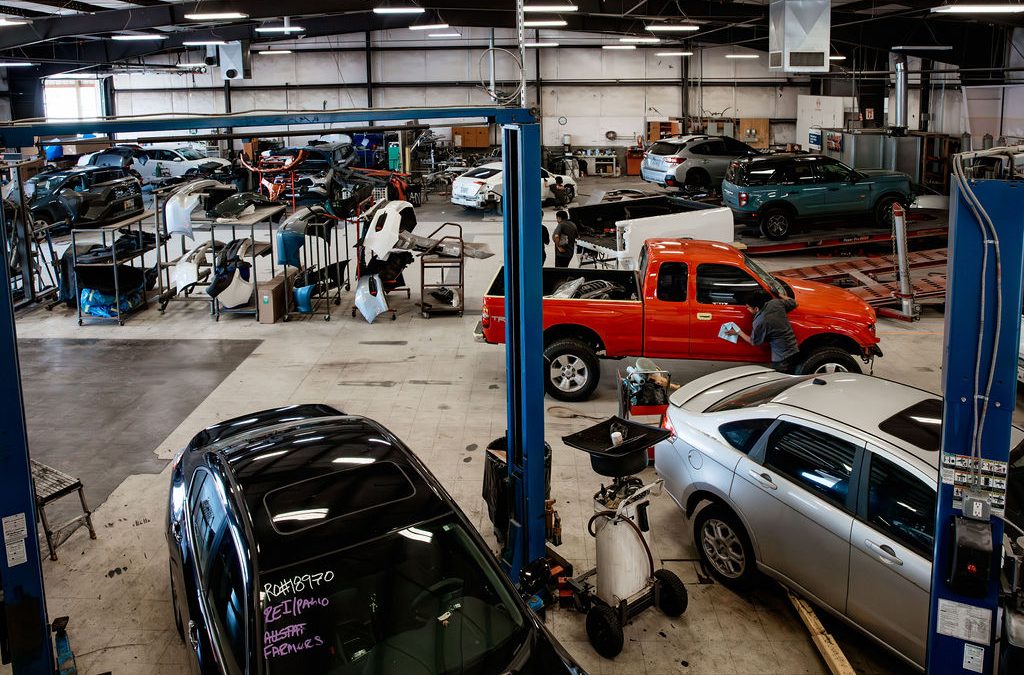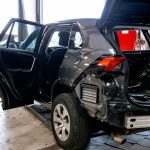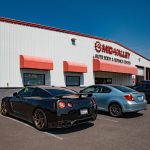Woodburn Auto Body Shop Repairs
Dealing with auto body shop repairs after an accident can be a challenging process. However, by partnering with a reputable and experienced auto repair shop like Mid-Valley Auto Body, you can ensure a seamless repair process and have your vehicle back in its pre-accident condition. Remember the importance of researching and selecting a trustworthy repair shop, working closely with your insurance provider to understand your coverage and claim options, and maintaining proper communication and transparency throughout the repair process. By embracing the values of purposefulness, resourcefulness, and resilience in the face of adversity, you can successfully navigate the process of auto body shop repairs after an accident and get back on the road with confidence.
Common Types of Auto Accidents
- Fender benders: Often occurring in low-speed environments, these minor collisions can cause dents, scratched paint, and misaligned body panels.
- Rear-end collisions: Resulting from sudden braking or acceleration, these accidents can lead to significant bumper and trunk damage.
- T-bone collisions: Typically occurring at intersections, these side-impact accidents may cause severe damage to vehicle doors and structural components.
Importance of Professional Repairs
- Safety: Proper auto body shop repairs after an accident ensure the vehicle’s structural integrity and safety systems are restored to their pre-accident condition.
- Resale value: Faulty or incomplete repairs can significantly decrease your vehicle’s resale value.
- Aesthetics: Quality repairs will return your vehicle to its pre-accident appearance, ensuring a consistent paint job and properly aligned body panels.
Selecting a Reliable Auto Body Shop
- Reputation: Research reviews and testimonials to gauge the Mid-Valley auto body shop’s credibility and customer satisfaction.
- Experience: A well-established auto body shop should have solid experience and expertise in handling diverse accident scenarios and vehicle makes and models.
- Warranty: Choose a repair center that offers a warranty on their workmanship and replacement parts, ensuring peace of mind in the quality of their services.
- Equipment: Look for a shop utilizing advanced equipment and techniques for more accurate, efficient, and high-quality repairs.
Insurance Claims Process
- Filing a claim: Contact your insurance provider after an accident to begin the claims process and discuss the specifics of your policy coverage.
- Estimating the damage: The insurance company may send an adjuster to inspect your vehicle and provide an estimate for repair costs.
- Partnering with the auto body shop: Your chosen repair shop should communicate with the insurance provider to ensure smooth coordination, accurate estimates, and timely repairs.
- Finalizing repairs: Before picking up your repaired vehicle, ensure that all necessary paperwork has been completed and all insurance claims have been settled.
Assessing Vehicle Damage
Types of Vehicle Damage
There are various types of vehicle damage that can result from accidents, each requiring a different approach for repair:
- Dents: Dents are common and occur when a vehicle’s body is struck, causing an indentation or depression. Panel beating or paintless dent repair may be utilized depending on the severity.
- Scratches and paint damage: Scratches occur when a sharp object or another vehicle makes contact with your car’s surface. Repairing scratches typically involves buffing, painting, and refinishing the affected area.
- Cracked or shattered glass: Windshield, windows, and side mirror damages need to be replaced to ensure safe driving conditions.
- Frame damage: Severe accidents may result in bent or twisted vehicle frames, requiring specialized frame straightening equipment and techniques.
- Mechanical issues: Accidents can also cause internal damages to the engine, suspension, transmission, or other vital components, requiring a separate approach during repairs.
Severity Levels
The severity of the damage after an accident will determine the extent of the required repairs and costs. There are generally three levels of severity:
- Minor: Minor damages such as small dents and scratches that do not impact the vehicle’s performance or safety can be addressed relatively quickly and affordably.
- Moderate: Larger dents, broken glass, or suspension damage may require more attention and higher costs but can still be repaired.
- Severe: Heavy damages, including frame or structural issues and major mechanical problems, may necessitate extensive repairs or even result in the vehicle being declared a total loss.
Safety Concerns
Repairing your vehicle after an accident is crucial for ensuring its safety. Some damages may not be immediately visible but could affect crucial systems, such as the airbags, brakes, or steering. It is vital to have a professional inspection at a reputable auto body shop to identify and address any safety concerns.
Initial Damage Estimate
An initial damage estimate helps determine the extent of the repairs required and their associated costs. This process typically involves a thorough inspection by an expert from a trusted auto repair shop or an insurance adjuster. The initial estimate should include:
- A comprehensive list of all damages and necessary repairs
- A breakdown of labor costs for each repair, including hours required and hourly rates
- An itemized list of required parts and their costs
- An estimated completion date for the repairs
Keep in mind, the initial estimate may change as additional damages are discovered during the repair process. Staying in communication with your repair shop and insurance agency during this time can help avoid unexpected surprises.
The Repair Process
Body Repair
When it comes to auto body shop repairs after an accident, the first step is addressing the damage to the vehicle’s body. Skilled technicians work tirelessly to bring your car back to pre-accident condition by:
- Assessing the extent of the damage
- Removing damaged parts and components
- Straightening or replacing bent metal frames
- Repairing or replacing damaged exterior panels
- Replacing any broken glass
It’s important to choose a reputable auto repair shop like Mid-Valley Auto Body to ensure your vehicle receives the highest level of care.
Painting and Refinishing
After the body repair is completed, the next step is painting and refinishing. This stage involves:
- Prepping the repaired or replaced panels for paint
- Matching the vehicle’s existing paint color
- Applying primer, basecoat, and clearcoat to the panels
- Buffing and polishing the finished paintwork for a seamless appearance
Professional shops use high-quality materials and state-of-the-art equipment to ensure the vehicle’s new paint job is durable, long-lasting, and matches the original color as closely as possible.
Mechanical Repairs
Sometimes, accidents can cause damage to a vehicle’s mechanical systems. Depending on the severity of the collision, mechanical repairs may be necessary, such as:
- Inspecting and repairing or replacing damaged suspension components
- Checking and repairing fluid leaks
- Assessing and addressing any damage to the engine or transmission
- Repairing or replacing any damaged electrical systems
In these cases, it’s essential to trust a shop like Mid-Valley Automotive to not only handle the auto body repair but also the necessary mechanical repairs.
Quality Control and Inspection
Before your vehicle is returned to you, a thorough quality control and inspection process is undertaken to ensure all repairs have been completed to the highest standards. This includes:
- Confirming all necessary repairs have been made
- Ensuring the vehicle’s paint job is consistent and matches the original color
- Inspecting mechanical systems to verify they are functioning correctly
- Double-checking that all electronic components are working as they should
- Test driving the vehicle to ensure it performs and handles as it did before the accident
By choosing a trusted auto body shop like Mid-Valley Auto Repair, you can rest assured that your vehicle has undergone a meticulous inspection process to ensure it has been returned to its pre-accident condition.
Working with your Insurance
Filing a claim
After experiencing an auto accident, you must navigate through the insurance claim process to get your vehicle back on the road. Some essential steps to follow when filing a claim include:
- Contacting your insurance company as soon as possible.
- Providing them with accurate information about the accident and the damage sustained.
- Collaborating with your insurance agent to understand your coverage and claim options.
Remember, timely action and clear communication are crucial to ensure a smooth process for auto body shop repairs after an accident.
Understanding your coverage
Before diving into the repair process, it’s essential to familiarize yourself with your insurance policy and understand what coverage you have. Typical coverage options include:
- Collision insurance: This covers damages caused by a collision with another vehicle or object.
- Comprehensive insurance: This covers damages from non-collision incidents like natural disasters, theft, and vandalism.
You might also want to check if you have any additional coverage options such as rental car reimbursement or roadside assistance. By understanding your coverage, you can make more informed decisions about Mid-Valley auto body repairs after an accident.
Dealing with adjusters
Dealing with insurance adjusters might be a daunting task, but it’s crucial to ensure a fair and accurate repair estimate. When working with adjusters, follow these tips:
- Be honest and thorough while describing the accident and damages.
- Provide any relevant documentation, such as photos, repair estimates, and police reports.
- Don’t hesitate to ask questions or clarify any doubts.
Always remember, adjusters are there to assess the damage and determine the repair cost, so your cooperation and patience are essential during this process.
Ensuring fair repair estimates
A fair repair estimate is vital to guarantee that your vehicle receives the necessary repairs without incurring unnecessary costs. Here are some tips to make sure your repair estimate is fair:
- Obtain multiple estimates from different valley auto repair shops to compare prices and services.
- Cross-check the insurance adjuster’s estimate with your chosen mechanic’s recommendations.
- Don’t be afraid to negotiate with your insurance company and advocate for your needs.
By following these tips and maintaining an open line of communication with both your insurance provider and your auto body shop, you’ll be well on your way to restoring your vehicle to its pre-accident condition.
Post-Repair Considerations
Vehicle Value After Repairs
Auto body shop repairs after an accident can impact your vehicle’s value. Understanding factors that affect its value is important to make informed decisions.
- Diminished value: Even if the repairs are done professionally, the mere fact that the vehicle has been involved in an accident might reduce its resale value. Check local regulations as some states allow for diminished value claims against insurance companies.
- Quality of repairs: Ensuring that the repairs are done by a reputable auto body shop is critical. High-quality repairs help maintain your vehicle’s value and performance.
- Inspection: After your vehicle is repaired, have it inspected by a third party or qualified mechanic to ensure the repairs were done correctly and effectively.
Maintenance Tips
Taking proper care of your vehicle post-repairs is crucial for longevity and value retention.
- Monitor performance: Pay close attention to your vehicle’s performance, looking for any changes that may indicate unresolved issues after the accident.
- Follow a maintenance schedule: Keep up with regular maintenance, such as oil changes, filter replacements, brake checks, and tire rotations. Regular maintenance will help identify potential issues early.
- Address potential issues: If you notice any issues post-repairs, contact your auto repair specialist immediately to discuss potential solutions.
Warranty Information
Understanding the warranty coverage provided on repairs is essential to ensure peace of mind.
- Repair warranty: Choose an auto body shop that offers a warranty on their repair work. A warranty demonstrates their confidence in the quality of their services.
- Manufacturer warranty: In some cases, repairs after an accident may affect the manufacturer’s warranty on your vehicle. Check with your vehicle manufacturer and auto body shop for specifics.
- Extended warranty: If you have an extended warranty on your vehicle, verify if your repairs are covered under it and the process to make a claim if necessary.
Ensuring Customer Satisfaction
As a vehicle owner, you should be satisfied with the repairs performed, and the auto body shop should ensure open communication throughout the process.
- Post-repair inspection: Request a thorough inspection of your vehicle post-repairs, making sure everything is functioning as it should.
- Open communication: Maintain a strong line of communication with the auto repair shop throughout the repair process. They should provide regular updates and address any concerns you may have.
- Issue resolution: If you encounter any issues after repairs, work closely with the auto body shop to resolve them promptly and to your satisfaction.




